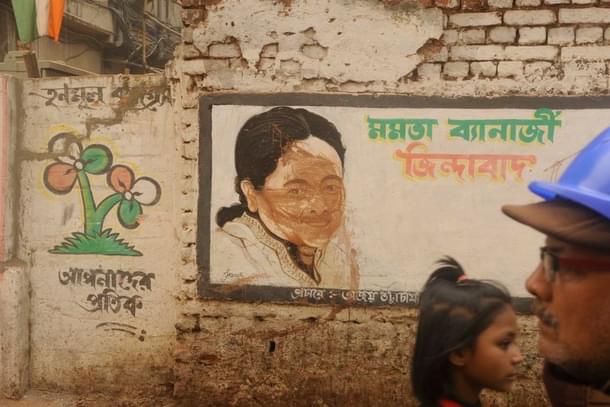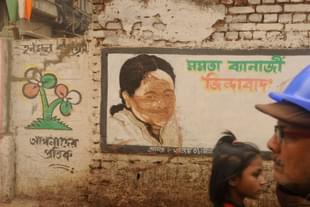Politics
The Beginning Of The End For Mamata Banerjee?
Jaideep Mazumdar
May 21, 2019, 01:48 PM | Updated 01:48 PM IST
Save & read from anywhere!
Bookmark stories for easy access on any device or the Swarajya app.


If Sunday evening’s exit polls are to be believed, the Bharatiya Janata Party (BJP) is set to bag anything between 11 to 23 Lok Sabha seats in Bengal. And the party’s vote share, which was 16.8 per cent in 2014, is projected to nearly double to 31.68 per cent this time. The BJP’s predicted win is, of course, the Trinamool’s loss. And, to a much lesser extent, that of the Left and the Congress as well, since many votes from these parties could shift to the BJP.
But the bigger question is: What happens to the Trinamool two years hence, when Assembly elections are due? Will the BJP be able to unseat Mamata Banerjee from power in 2021? The answer, in all likelihood, is ‘yes’ and there are many reasons for that. The primary one is that there is limited room for a course-correction by Trinamool to recoup the losses it is likely to suffer this time.
That is probably owing to the irreversible choices Mamata Banerjee has made since assuming office in 2011. She inherited a highly politicised bureaucracy and police force, a demotivated state administration that was a mere adjunct of the then ruling party, a culture of political violence and intimidation and suppression of opposition through violent and undemocratic means, in addition to an economy that was in ruins.
The 34 years of Left rule in Bengal was characterised by all this as well as overt appeasement of minorities, unemployment, industrial decline, undermining of democratic institutions and traditions, and widespread repression through the misuse of a pliant state machinery.
Mamata Banerjee rode to power on a virtual tsunami of popular anger and disgust with Left rule. One major tremor which triggered that tsunami was Singur, and that was a harbinger for the future. Mamata Banerjee fuelled the protests of land-losers in Singur against the forcible acquisition of land there for the Tata Motors plant.
She remained adamant in not allowing construction of the plant to proceed even after the then Buddhadeb Bhattacharjee government agreed to offer hefty compensation packages to the land-losers. And ultimately, she drove the Tatas out of Singur, a disaster that has left a permanent black mark on Bengal as an investment destination and made all potential investors wary of Bengal under Banerjee.
This single and significant act provided a firm indication of her politics and priorities. That she was more communist than the communists themselves became a legitimate apprehension among the people.
After assuming office on the promise of ‘poriborton’ (transformation), she had been gifted a golden opportunity to bring in change for the better in Bengal. Instead of professionalising the state administrative machinery, she chose to politicise it further, as a result of which the newly energised ‘Frankenstein’ turned out to be a further bane for the citizenry.
On the economic front, she chose fiscal irresponsibility by announcing sops and doles, plunging an-already debt-ridden treasury into further chaos. Under her tenure, Bengal’s debt burden doubled to what it was in 2011. Her demand for a total debt waiver or decade-long moratorium on debt repayments was turned down by New Delhi, which triggered characteristic animosity.
Another point of disappointment as far as the people of Bengal is concerned is her outright refusal to join the Ayushman Bharat scheme of the centre, owing to strained state-centre relations.
Soon after assuming office, she realised that whatever be her efforts, investments, especially big-ticket ones, would not flow into Bengal after her stand on Singur. With jobs not being created in the state, she took to handing out doles and sops to the people. Many welfare schemes were announced and implemented to retain the support of the masses. But these played havoc with the state’s worsening finances.
Also, the positive effects of the social welfare schemes she rolled out have often been negated by her party functionaries who forcibly took away a part of the welfare pie, leaving little for the common man to savour. It is a common refrain among the people of the state that they have had to share the amounts they receive towards welfare, with Trinamool functionaries, or else whatever little benefit is obtained would also disappear.
Such unchecked corruption has now come to haunt the Trinamool chief, who is now realising the impact it has had on the people, and the resultant benefit that the BJP might possibly accrue.
With the BJP now posing a serious challenge to the ruling party, and possibly even an existential threat, the leadership of the Trinamool seems panic-stricken. This could explain the violence that the state has witnessed around poll time.
Another major issue driving the average Bengali Hindu voter away from the Trinamool is the party’s blatant appeasement of minorities. The Muslim peasantry in rural areas supported Mamata solidly in 2011 and brought her to power. Muslims, who form nearly 30 per cent of Bengal’s electorate, formed the backbone of support for the Trinamool.
Mamata realised that the community was now critical for the party as it mostly votes en masse. With the illegal influx and settlement of Bangladeshi refugees in Bengal, widely believed to have been engineered to add meat to the Trinamool vote bank, the alienation of the otherwise secular Hindu has begun.
Come 23 May, the picture will be clear and one will know what the impact of this whole saga actually means.
Jaideep Mazumdar is an associate editor at Swarajya.





